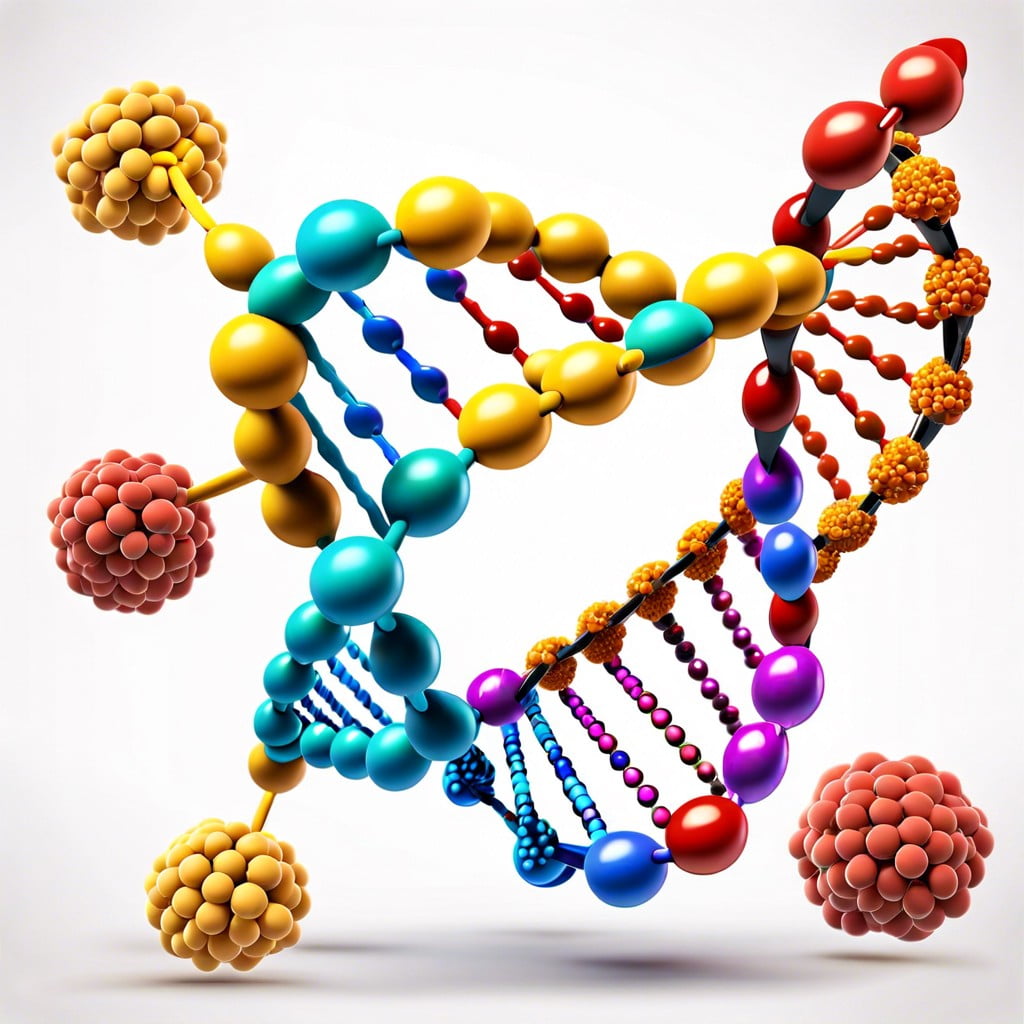In this article, you will learn about DNA polymers, the essential molecules that store and transmit genetic information in all living organisms.
Key takeaways:
- DNA is made up of nucleotides and forms a double helix structure.
- The sequence of bases in DNA encodes genetic information.
- DNA has various functions, including heredity, regulation, and protein synthesis.
- The process of DNA replication ensures accurate transmission of genetic information.
- Proteins interact with DNA to interpret and carry out genetic instructions.
DNA: Polymer of Nucleotides

DNA is the blueprint of life made of long chains of nucleotides, each consisting of a sugar, a phosphate group, and a nitrogenous base.
There are four types of bases: adenine, thymine, cytosine, and guanine.
These pair specifically: adenine with thymine and cytosine with guanine, forming the rungs of the DNA ladder-like structure known as a double helix.
The sequence of these bases encodes genetic information.
Due to the precision in base-pairing, DNA can be copied with high fidelity.
This ensures that genetic information is transferred accurately when cells divide, enabling growth, repair, and reproduction.
The structure of DNA also allows it to interact with various proteins, which regulate genetic expression and use DNA’s instructions to perform life’s essential functions.
DNA’s versatility and complexity make it an astonishing polymer that’s central to biological systems.
Properties of DNA
DNA, a biopolymer, exhibits a helical double-strand structure composed of nucleotide monomers. Each nucleotide consists of a sugar molecule, a phosphate group, and a nitrogenous base—adenine (A), thymine (T), cytosine (C), or guanine (G). These bases pair specifically: A with T and C with G, which gives DNA its unique code for genetic information.
The stability of DNA is due to hydrogen bonding between complementary bases and hydrophobic stacking interactions between the aromatic bases. DNA strands are antiparallel, meaning one strand runs in a 5’ to 3’ direction, while the complementary strand runs in a 3’ to 5’ direction. This orientation is critical for replication and other cellular functions.
Being a negatively charged molecule due to its phosphate backbone, DNA interacts with various proteins, which aids in its packaging within the cell and its involvement in the transcription process. DNA’s ability to replicate accurately and repair itself ensures the transmission of genetic information from cell to cell and generation to generation.
Biological Functions of DNA
DNA houses the instructions needed for an organism’s development, function, growth, and reproduction. These instructions are found within the sequence of four types of nucleotides—adenine (A), thymine (T), guanine (G), and cytosine (C)—which make up the DNA molecule.
The sequence determines how an organism is built and how it will function. It’s comparable to the way letters form words and sentences to convey information. In DNA, the sequences spell out genetic instructions essential for the cellular machinery.
DNA’s role in heredity is central, as it’s passed from parents to offspring. Each cell in an organism has the same genetic information, and this is what makes each species unique.
Another critical function is its capability for variations and mutations. Although these may sometimes lead to diseases, they also drive evolution by introducing new traits that can be advantageous.
The polymer also has a regulatory function, as parts of the DNA are responsible for turning genes on or off. This ensures that the right proteins are made at the right time and place.
In the cell’s daily operations, DNA is constantly being read and used to produce proteins, which perform most of the work within cells. This process of protein synthesis is an elegant dance of biology, orchestrated by DNA.
Lastly, the polymer’s structure allows it to self-repair, ensuring integrity and continuity of the genetic information through generations.
Replication of DNA
DNA replication is a critical process that ensures each new cell contains an exact copy of the original genetic code. This process is highly regulated and occurs in a series of steps:
– **Initiation**: Special proteins bind to the DNA at specific starting points and begin to unzip the double helix into two single strands, creating a replication fork. – **Elongation**: An enzyme called DNA polymerase attaches to each strand. It reads the existing DNA bases and adds complementary nucleotides, growing a new strand. – **Leading and Lagging Strands**: One new strand, the leading strand, is made continuously. The other, the lagging strand, is constructed in short segments, later joined together. – **Proofreading**: DNA polymerases also have the ability to check and correct errors, ensuring the accuracy of the replicated DNA. – **Termination**: Once the entire DNA molecule has been replicated, the process concludes, resulting in two identical DNA molecules ready for cell division.DNA Interactions With Proteins
Proteins play a pivotal role in interpreting the genetic code held within DNA, serving as vital intermediaries in the translation of genetic information into the actions and components of cells. Here are some key points to understand about how this interaction unfolds:
1. Recognition: Certain proteins, known as transcription factors, bind to specific sequences of DNA. These sequences often reside near genes and control their activity.
2. Structure: Histones are proteins around which DNA winds, forming a complex called chromatin. This packaging allows for the efficient management of genetic material within the nucleus.
3. Replication and Repair: Enzymes, which are also proteins, facilitate the replication of DNA and repair any damage. DNA polymerases are the star players in the replication process, copying DNA with remarkable fidelity.
4. Expression: Ribosomes, composed partly of ribosomal proteins, are the sites where DNA’s instructions are translated into proteins. This process, known as protein synthesis, is central to cell function.
5. Regulation: Proteins such as repressors and activators can either inhibit or enhance gene expression, ensuring that the right genes are active at the right times.
Through these interactions, proteins help convert the static information of DNA into dynamic processes that power life, illustrating the integral relationship between DNA and proteins in biology.
Recap




